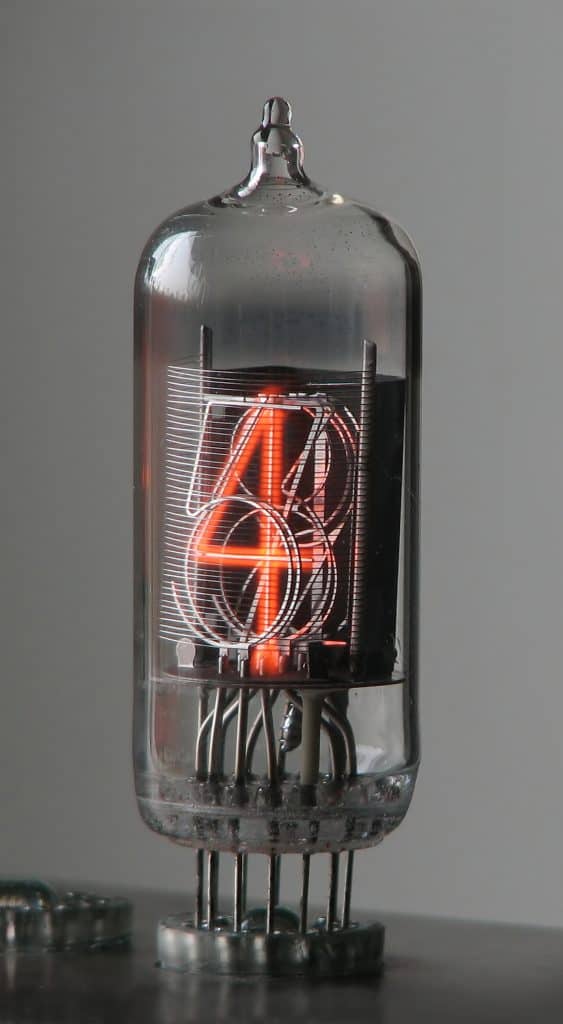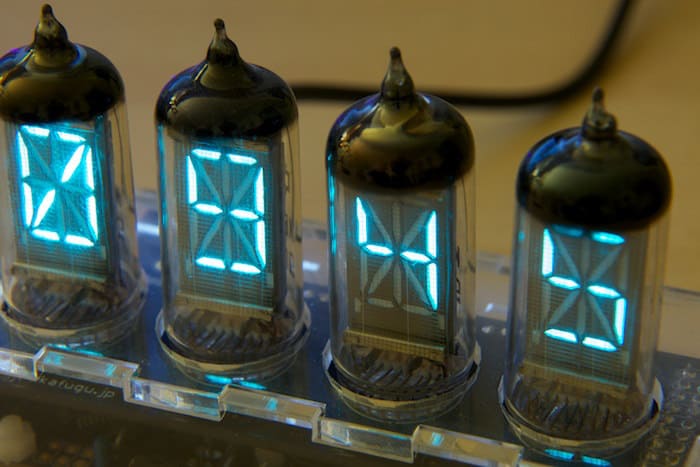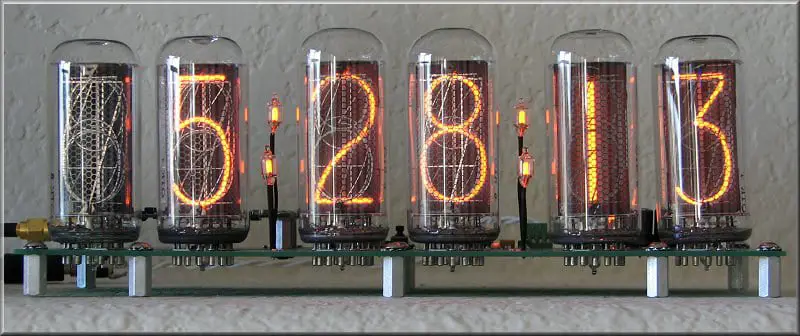Chances are you have dozens of devices in your home that display numbers. You deal with them every day, microwaves, ovens, alarm clocks, calculators and any electronic device that has a screen with a timer on it. If the numbers are blue in color, it means they are made of vacuum fluorescent displays (VFDs). But if they’re red-orange, they’re likely made of light emitting diodes (LEDs).
Both the two concepts work by lighting several bars that compose the numbers. There are 7 bars that light in a different way to create any digit from 0 to 9. Nixie tubes work a little differently to show digits from 0 to 9; they don’t use any bars to light up and compose the numbers.
If you want to create sophisticated colors of light, such as a calculator or a clock, you need a technology that is up to the task. Modern numeric displays are based on LEDs, LCDs, and VFDs. However, back in the 1950s, before these fancy technologies were perfected, electronic boxes used glowing lamps called nixie tubes.
The tubes have recently made a comeback in retro-style clocks, and vintage tech and steampunk enthusiasts are all diving in. But if you’re new to steampunk gadget and some of the technology behind them, you must be wondering, what are nixie tubes and how do they work?
What is a Nixie Tube?
Before delving deeper into nixie tube clocks, I thought we should take a moment to understand a little more about the nixie tube concept. As mentioned, nixie tubes display numbers a bit different from the likes of LEDs and VFDs.
You will often see them with digits made out of bent wire and arranged in a stack, one in front of the other, inside a sealed glass tube. If the tubes are wired appropriately, the numbers can tell time, count in sequence, or do a wide range of sophisticated things.
By definition, a nixie tube also referred to as ‘cathode-ray display,’ is an electric concept/device for displaying numerals and other forms of information using glow discharge. The nixie tube glass itself contains a wired mesh anode and a number of cathodes which are shaped in the form of numbers or other symbols.
The tube is usually filled with gas at low pressure, mostly neon and a bit of argon or mercury. The gases are invisible, so you might not see them by just looking. The sealed tube is meant to stop the gases from escaping. Unlike in incandescent lamps, the bent metal wires are not filaments. Each nixies tube has ten cathodes to represent all the numerals from 0 to 9.
The cathodes are separated from each other by thin ceramic spacers. When the power is switched on, the atoms of neon gas are split apart inside the tube to make electrons and ions, which collide, and give off red-colored light. In some way, nixie tubes are similar to neon lamps.
The fuzzy glowing “coating” of light that forms follows the cathode’s shape very precisely, making it appear as if one of the numbers has been illuminated.

In incandescent lamps, the coiled filament glows hot white or hot red due to heat. But in Nixie tubes, the cathode remains cold, and the glow happens a small distance away from the cathode producing it. This concept is known as ‘cold-cathode glow discharge.’ Most of the glow produced from the nixies tube comes as a result of collisions between gas ions, atoms, and electrons, more like in the neon tubes.
The best part about nixie tubes is that they’re easy-to-read and the numbers are properly rounded, unlike the “compromise” squared-off digits produced by LCDs, VHDs, and LEDs (which can be very confusing in some cases). This is what makes them the best options for clocks and other instruments that need to be read in darkness, poor lighting, or at a glance.
While they’re essentially obsolete, nixie tubes are incredibly reliable, which is why they are making a comeback with the renewed interest in nixie tube clocks and other cool vintage steampunk gadgets and gizmos. Even if one or more of the other cathodes fail, the remaining cathodes will still continue working.
The only downside of the nixie tubes is that they require quite a large amount of voltage to power them, which makes it hard to integrate them in relatively small, low-voltage computer chips.
Since the nixie tube contains mercury, it can present a health hazard if it breaks –although this is quite rare since it’s constructed sturdily. Nixie tubes are also relatively large compared to other modern displays, making them hard to incorporate in extremely compact gadgets.
So, What is a Nixie Tube Clock?
Having discussed the core concept surrounding nixie tubes, it should be easier to understand the designs and workings of nixie tube clocks. Primarily, nixie tube clocks are digital clocks that contain a nixie tube. As mentioned, nixie tube displays are largely obsolete, but as of today, there is no modern technology that can replace their peculiar look and working concept.

VFD is quite popular in home audio/video devices, cash register displays, and old calculators, and can also be produced in a flat design. While they might look identical, these are actually not called nixie tube clocks. The traditional LCD/LED display clocks that have the LCD/LED assembled in tubes also resemble nixie designs, but they are not nixie tube clocks either.
Nixie tube clocks are getting increasingly popular with not just geeks, but people who love/appreciate vintage and steampunk gadgets and technology. Some people do build them on their own either from scratch or from kits.
Nixie tubes clocks look extremely cool, and they’re not only hobby projects for the electronic enthusiast but also functional day-to-day gadgets that you can integrate into your daily life.
Nixie Tube Clock features
Away from the display, the nixie tube clocks work the same way as the other digital clocks. They come with separate specialized integrated circuits, and most of them are built from a microcontroller and separate driver/power supply circuits. The top typically features two circuit boards, one for the Nixie tubes and the other for optional LED backlights. The LED lights can be in blue, green, red, yellow, etc. and the light at the base of each tube.
There is a button battery that provides back-up power, which means you don’t need to reset the clock when there is a power outage. The neon display at the base of the tubes usually goes off when the power is cut out to preserve the battery.
Standard nixie tube clocks often display the date and time in minutes and seconds, but more sophisticated models additionally display pressure (with units and trend), temperature and, humidity.
Two single neon lamp-based separators typically separate the time and date displays. A majority of the Nixie clocks use “Direct/Static Drive,” and the circuit board details and specifics will vary from one manufacturer to another. Depending on the design specifics, the clock may chime after 15, 30, 45, or 60 minutes. The top-of-hour chime is distinctive.
Some models switch off all the tubes when the light level in the room dims to a specific level, like at night, which helps to extend the life of the tubes. Larger models have mechanisms to dissipate any heat using copper wings attached to the ICs or a tiny fan inside the clock box that draws cool air in and warm air out.
Of course, the clock comes with control buttons for adjusting the time, date, chimes, and chime volumes. Temperature, pressure, and humidity displays would typically be located at the back of the clock away from the influence of the internal clock temperature.
Some really cool, latest designs come with remote control for setting time, date and neon light illumination. You also get to set things like how the clock transitions between number displays, as well as the intensity of the cathode glow.

Other features
Want to get fancier? Well, unlike the traditional nixie tube clocks and the technology itself, today’s models have managed to blend the steampunk nixie tube technology with modern tech.
You can now find nixie tube clocks that have internet connectivity. With the Wi-Fi module and online connectivity, the time can be automatically synchronized without you having to reset it manually.
Other models even allow you to control the setting from online cloud-based apps –yes, some have apps too, cool, right? Cathode poisoning prevention feature is also a handy addition to prevent some digits from damaging if they’re not used more often.
The bottom line
Nixie tube clocks and nixie tube technology is quite impressive. If you appreciate vintage technology and steampunk gadgets, you will definitely love having this piece on your living room corner table.
It also works as a great conversational starter when placed on a work table, other than actually being able to tell time, date and additional info precisely.
As the original nixie tubes become more and more difficult to find, companies are creating their own alternatives. Today’s tubes are smaller, slimmer, and require lesser power to operate than before. Most of them now have a “smart base” that holds smart circuits for advanced control and interaction.
It’s estimated that latest nixie tube clocks can last up to 20-30 years, that’s quite something for an ancient-modern technology (or modernized-ancient technology, if you like).
If you’re into steampunk gadgets and gizmos, or generally fancy vintage technology, a nixie tube clock is something you definitely need to add to your functional collectibles.
For a great selection of Nixie clocks check out Etsy.


